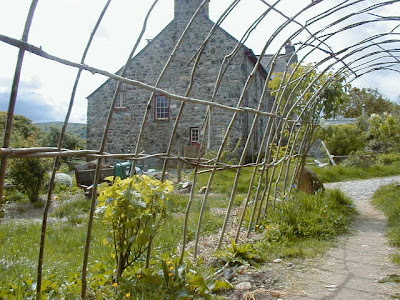I suspect that I would appear so to some. I don’t feel part of a consciously distinct tribe of folk, though on off days notice my appearance can draw hostile looks in the street, as if I represent some kind of threat.
We all orbit around the tribal camp-fire at a distance that we continually negotiate to balance our needs to belong and to be separate.
One Age's eccentric is another’s regular citizen. Behaviour and values change: just look at how Prince Charles’ green attitudes have moved from fringe to mainstream acceptability in a decade.
It used to be a cultural norm for a man of letters to cultivate a personal set of beliefs and understandings, based on study of other self motivated individuals. Adherence to a personal set of beliefs is to verge on weird in present culture; a luxury of mind indulged in singer-songwriters and fringe comedians, who often pay for their indulgence by having breakdowns.
If you take truth more seriously than conformity, maybe the visual filter of your appearance is a handy tool to pick out like souls with.
Looking back, there were key choices I made that seemed simply inevitable.
Like the need to live on and from the Land. That narrowed into being the ‘natural world’, which meant hunting and gathering, though I did a dutiful stab at sufficiency in my garden. I was a child of the Sixties. A dress rehearsal for the end of the world.
citizen[d] of the world
Deciding to try to live like this, closed thousands of other wormholes of opportunity, otherwise known as careers.
We all make such key choices, often casually, almost in passing.
My chorus amongst those choices and their consequences, was that they were right, whatever their outcome.
The alternative chorus is ‘if only this, if only that..’. The path to victimhood.
My trajectory around Tribe Man was set, and I have negotiated from inside that orbit ever since.
I started trading regularly with the City, which highlighted my separateness, turning it to advantage.
I felt and thought harder about the politics of the divide between the city and the countryside. The guilt-weighted, feudal transaction.
A jolt in my orbit sent me spinning at fifty into a hut in a wood. According to my twin-sister, I had been abducted by a wood-witch.
I had found a valley peopled by other radicals or their ghosts. More than that, it was a place where nature-spirits are a vocal majority.
In the Sixties there was a ‘my-gang’ streak in alternative culture. Some of this was the neurosis of dope use, which saw itself as the source of all creativity and pitied ‘straights’ as cardboard cutouts.
That, and the wave of drug-wounded disillusionists that followed, are not apparent here apart from a few token shrunken breakfast-spliff smoking hermits.
There are tales of a lemming wave who followed some guru into the sunset, just like the tide of blissed-out Divine Light premies who wandered the streets of Aberystwyth once.
There are local traditions of circle dancing and a strong culture of alternative healing as a legacy of the time.
This is the valley of John and Sally Seymour, who reawakened our imaginations to the idea of Sufficiency, of living from the land in the Sixties. The TV comedy ‘The Good Life’ is ironically the longest vapour-trail we still see from those times.

Also the valley of Brithdir Mawr, who have managed to promote the ideals of low-impact living through a long-spun legal battle with a Planning Authority who have seemed intent on making fools of themselves, about Jane Faith and Tony Wrenchs’ turf-roofed Roundhouse.
Also of other homespun heroes, intent on doing rather than prating, who were often wary of the spotlight that might fall on their illegal homestead in the woods from such attention.
It feels like old adversities are stil being acted out here; the Romans and their great-nephews the Normans stalked around this valley’s fringe, but somehow there were always people and lore, outside their jurisdiction, within.
There are inbuilt antagonisms between the dispossessed locals and hippie incomers, but these are confused by the intense predujices of the prosperous retired, who share nothing much in common with either.
I felt enough part of some vague tribe to feel at home. There is a taciturn trust between us all as the arrogant home-county families start to fill up shop and street in the Summer. Newport high street becomes a canyon through which convoys of honcho-ponchos carry these affluent broods.
Part of the alternative social contract here is that we all Have Work To Do. I have been reminded often not to waste too much of my time on observing others, but to sort myself out...